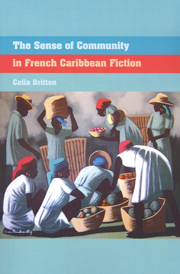Book contents
- Frontmatter
- Contents
- Acknowledgements
- Abbreviations
- Introduction
- 1 Restoring Lost Unity in Jacques Roumain's Gouverneurs de la rosée
- 2 Past, Future and the Maroon Community in Edouard Glissant's Le Quatrième Siècle
- 3 Living by Mistake: Individual and Community in Simone Schwarz-Bart's Pluie et vent sur Télumée Miracle
- 4 Singular Beings and Political Disorganization in Vincent Placoly's L'Eau-de-mort guildive
- 5 Conquering the Town: Stories and Myth in Patrick Chamoiseau's Texaco
- 6 Community, Nature and Solitude in Daniel Maximin's L'Ile et une nuit
- 7 On Not Belonging: Surrogate Families and Marginalized Communities in Maryse Condé's Desirada
- Conclusion
- Notes
- Bibliography
- Index
5 - Conquering the Town: Stories and Myth in Patrick Chamoiseau's Texaco
- Frontmatter
- Contents
- Acknowledgements
- Abbreviations
- Introduction
- 1 Restoring Lost Unity in Jacques Roumain's Gouverneurs de la rosée
- 2 Past, Future and the Maroon Community in Edouard Glissant's Le Quatrième Siècle
- 3 Living by Mistake: Individual and Community in Simone Schwarz-Bart's Pluie et vent sur Télumée Miracle
- 4 Singular Beings and Political Disorganization in Vincent Placoly's L'Eau-de-mort guildive
- 5 Conquering the Town: Stories and Myth in Patrick Chamoiseau's Texaco
- 6 Community, Nature and Solitude in Daniel Maximin's L'Ile et une nuit
- 7 On Not Belonging: Surrogate Families and Marginalized Communities in Maryse Condé's Desirada
- Conclusion
- Notes
- Bibliography
- Index
Summary
Texaco is set against the background of the steady influx of Martinique's population from the countryside into the towns, a process which started in the mid-nineteenth century with the abolition of slavery and continued in successive waves up until late in the twentieth century. The building of new communities and the polarity between town and country are thus important themes. The first words of the text, introducing a chronology of the historical and fictional events covered by the novel, are:
Afin d'échapper à la nuit esclavagiste et coloniale, les nègres esclaves et les mûlatres de la Martinique vont, de génération en génération, abandonner les habitations, les champs et les mornes, pour s'élancer à la conquête des villes (qu'ils appellent en créole: ‘l'En-ville’). Ces multiples élans se concluront par la création guerrière du quartier Texaco et le règne menaçant d'une ville démesurée.
(p. 13)For the workers on the plantations, in other words, the towns appear as beacons of freedom – Saint-Pierre and Fort-de-France ‘[tenaient] lieu de flambeau dans la nuit close des chaînes’ (p. 223) – but also as formidable enemies whom they have to fight in order to gain a foothold in them: Marie-Sophie says of Fort-de-France ‘Nous étions venus pour ses promesses, son destin, nous étions exclus de ses promesses, de son destin. Rien n'était donné, il fallait tout essoucher’ (pp. 404–405).
- Type
- Chapter
- Information
- The Sense of Community in French Caribbean Fiction , pp. 93 - 110Publisher: Liverpool University PressPrint publication year: 2010



